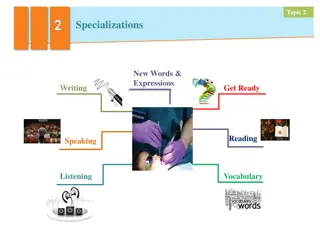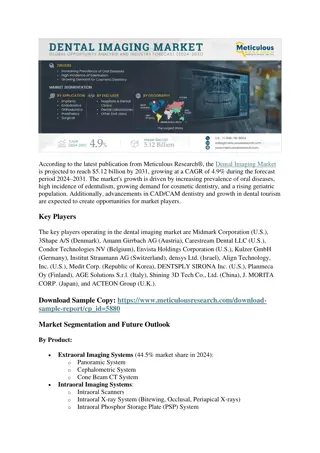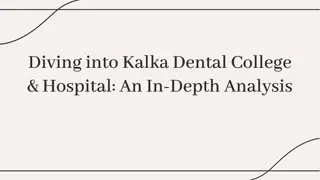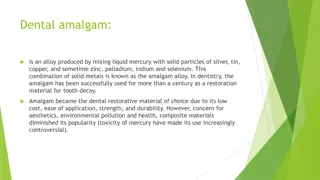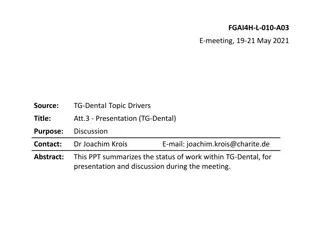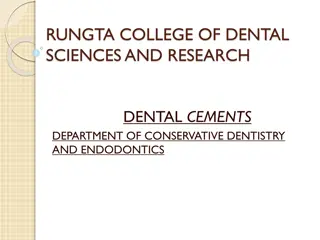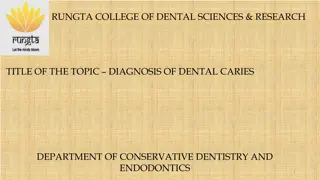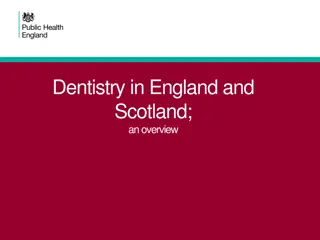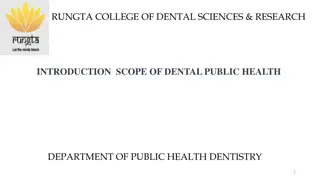Overview of Dental Amalgam in Dentistry
Dental amalgam is an alloy used in dentistry for over a century to restore tooth decay. It is a mixture of mercury, silver, tin, copper, and other metals. While dental amalgam has advantages like durability and low cost, concerns over aesthetics, environmental impact, and health risks have led to its declining popularity. The alloy's composition, uses, advantages, disadvantages, and functions of each constituent metal are explored.
Download Presentation

Please find below an Image/Link to download the presentation.
The content on the website is provided AS IS for your information and personal use only. It may not be sold, licensed, or shared on other websites without obtaining consent from the author.If you encounter any issues during the download, it is possible that the publisher has removed the file from their server.
You are allowed to download the files provided on this website for personal or commercial use, subject to the condition that they are used lawfully. All files are the property of their respective owners.
The content on the website is provided AS IS for your information and personal use only. It may not be sold, licensed, or shared on other websites without obtaining consent from the author.
E N D
Presentation Transcript
Dental amalgam: is an alloy produced by mixing liquid mercury with solid particles of silver, tin, copper, and sometime zinc, palladium, indium and selenium. This combination of solid metals is known as the amalgam alloy. In dentistry, the amalgam has been successfully used for more than a century as a restoration material for tooth decay. Amalgam became the dental restorative material of choice due to its low cost, ease of application, strength, and durability. However, concern for aesthetics, environmental pollution and health, composite materials diminished its popularity (toxicity of mercury have made its use increasingly controversial).
Uses of the amalgam : Amalgam is used most commonly for direct permanent posterior restorations and for large foundation restorations. It may be used for cores with crowns.
Advantages of dental Amalgam 1) Reasonably easy to insert. 2) Not sensitive technique. 3) Maintain anatomical form. 4) Have reasonably adequate resistance to fracture (strength). 5) Prevent marginal leakage after a period of time in the mouth. 6) Can be used in stress bearing areas. 7) Have a relatively long service life (durability). 8) Low cost.
Disadvantages of dental amalgam 1) The silver color does not match tooth structure. 2) They are somewhat brittle, subject to corrosion and galvanic action. 3) May demonstrate a degree of marginal breakdown. 4) Do not help retain weakened tooth structure. 5) There are regulatory concerns about amalgam being disposed in the wastewater
Composition The amalgam alloy consists essentially of silver and tin. In lesser amounts Copper, zinc, and a trace of gold, palladium, indium, selenium.
Function of each constituent : Silver (Ag): 1. Major element in the reaction and whitens the alloy 2. Decreases the creep. 3. Increases strength, setting expansion and tarnish resistance . Tin (Sn): 1. Tin controls the reaction between silver and mercury, without Tin the reaction will be too fast and the setting expansion will be unacceptable. 2. Reduces strength and hardness and resistance to tarnish and corrosion
Copper (Cu): 1. Increases hardness and strength. 2. Increases setting expansion. Zinc ) Zn): 1. Zinc acts as a scavenger or deoxidizer during manufacture (prevents the oxidation of the elements like silver, copper or tin). Alloy without Zinc are more brittle, and amalgam formed by them are less plastic. 2. Zinc causes delayed expansion if the amalgam mix is contaminated with moisture during manipulation.
Classification of Amalgam alloys Based on copper content (most popular one) 1) Low copper alloys: (5% or less copper) it is either irregular (lathe-cut) or spherical in shape. 2) High copper alloys: (13% to 30% copper) either a. Admixed or dispersion or blended alloys b. Single compositional or uni composition alloys Based on zinc content 1) Zinc containing alloys: contain more than 0.01% Zinc. 2) Zinc Free alloys: contain less than 0.01% Zinc . Based on shape of the alloy particle: 1) Lathe cut alloys or irregular shape. 2) Spherical alloys . 3) Mixture of lathe- cut and spherical particles
Based on number of alloyed metals: 1) Binary alloys, e.g. silver-tin. 2) Ternary alloys, e.g. silver-tin-copper. 3) Quaternary alloys, e.g. silver-tin-copper-indium.
Properties of set amalgam Dimensional change: freshly mixed Amalgam would neither expand nor contract as it sets after it is condensed into a cavity preparation. Expansion may result in post placement sensitivity or protrusion from the cavity. Whereas contraction would leave gaps between the restoration and the tooth prone to leakage and recurrent decay. In general most amalgams expand or contract only slightly during setting.
The initial contraction after short time (the first 20 minutes after tirturation) is believed to be associated with the solution of mercury in the alloy particles. After this period an expansion occurs which is believed to be result of reaction of the mercury with silver and tin (although the total change remains negative). If there is sufficient mercury present to provide a plastic matrix, an expansion will occur while reducing mercury in the mix will favor contraction
Factors favoring contraction 1. Low mercury/alloy ratio. 2. Higher condensation pressure (squeezes out mercury . 3. Smaller particle size ( accelerate mercury consumption because of its larger surface area 4. Longer triturating times (accelerates setting). Modern amalgams show a net contraction, whereas older amalgams always showed expansion. Two reasons for this difference are-: Older amalgams contained larger alloy particles and were mixed at higher mercury: alloy ratios. Hand triturating was used before ,Modern amalgams are mixed with high speed amalgamators (equivalent to increase in triturating time)
The dimension become nearly constant after 6 to 8 hours, and thus the values after 24 hours are final values .The only exception to this statement is the excessive delay dimensional change resulting from contamination of zinc containing alloy with water during triturating or condensation. It is usually starts after 3-5 days and may continue for months. This is known as delayed expansion or secondary expansion.
Strength: -Hardened amalgam has good compressive strength. But cannot with stand high tensile or bending strength. Therefore the cavity design should be such that the restoration will receive compression forces and minimize tension or shear forces in service.
The factors affecting strength of the amalgam are: 1) Effect of triturating. Either under-trituration or over-trituration will decrease the strength of both low copper and high copper amalgams. 2) Effect of mercury content. Sufficient mercury should be mixed with the alloy to wet each particle of the alloy. Otherwise a dry, granular mix results which has rough and pitted surface that increase corrosion. Excess mercury in the mix can produce a marked reduction in strength because high mercury amalgam have more 2 content (which is weakest phase) 3) Effect of condensation: in lathe cut alloy and admixed alloys the higher condensation pressure results in higher compressive strength (good condensation technique will minimize porosity and remove excess mercury from lathe cut amalgam). While the spherical amalgam condense with lighter pressures produce adequate strength (If heavy pressure is used the condenser will punch through).
4) Effect of rate of hardening Amalgam does not gain strength as rapidly as might be desired. Patient should be cautioned not to bite too hard for least 8 hours after placement. The time at which at least 70% of its strength is gained. 5) Effect of cavity design: The cavity should be designed to reduce tensile stresses. Amalgam has strength in bulk; therefore, the cavity should have adequate depth . 6) Effect of porosity. Voids and porosity reduce strength. Causes of the
porosity are :- A) Decrease plasticity of the mix caused by: 1. Too low Hg\alloy ratio. 2. Under trituration. 3. Over trituration. B) Inadequate condensation pressure. Increase condensation pressures improve adaptation at margins and decrease the number of voids. C) Irregularly shaped particles of alloy powder. voids are not problem with spherical alloys D) Insertion of too large increments.
Creep: permanent deformation under static loads (a time dependent plastic deformation). Creep of dental amalgam is a slow progressive permanent deformation of set amalgam which occurs under constant stress (static creep) or intermittent stress (dynamic creep). Creep is related to marginal breakdown of low copper amalgams. The higher the creep, the greater is the degree of marginal deterioration (ditching(. Creep causes the amalgam to flow over time such that unsupported amalgam protrudes at the margin of the restoration
The highest value of creep was found for the low-copper lath cut alloy, and the lowest values were determined for the high-copper (The 2 phase is associated with higher creep rates). Increase in zinc content gives less creep. Effect of manipulative variables (for increase strength and low creep) 1) Decrease the Hg\alloy ratio. 2) Maximum condensation pressure applies for lathe cut or admixed alloys. 3) Either under or over-trituration or delayed condensation tend to increase the creep rate.






